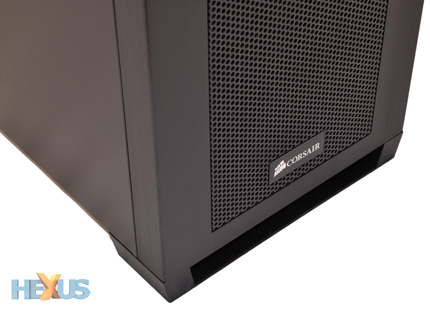Thermal performance
To see how well the Obsidian Series 650D can cool our high-end test bench, we're comparing it against a trio of high-end chassis; the Antec Lanboy Air, Thermaltake Level 10 GT and Corsair's own Obsidian Series 800D. Here are the pertinent specifications of all four chassis, as well as a breakdown of our test system configuration:
Comparison Chassis |
||||
|---|---|---|---|---|
| Corsair Obsidian Series 650D | Antec Lanboy Air | Thermaltake Level 10 GT | Corsair Obsidian Series 800D | |
| Case type | Mid-tower | Mid-tower | Full-tower | Full-tower |
| Dimensions (W x H x D) | 229mm x 521mm x 546mm | 222mm x 518mm x 490mm | 282mm x 584mm x 590mm | 229mm x 609mm x 609mm |
| Weight | 11.11kg | 9.2kg | 12.7kg | 10.2kg |
| Available colours | Black | Yellow/Black, Red/Black, Blue/Black | Black with red highlights | Matte black |
| Material | Aluminium faceplate and steel structure | Steel frame and mesh panels | Steel and plastic | Aluminium faceplate and steel structure |
| Motherboard support | mATX, ATX | mini-ATX, mATX, ATX | mATX, ATX, eATX | mATX, ATX, eATX |
| 5.25in drive bays | 4 | 3 | 4 | 5 |
| 3.5in / 2.5in drive bays | 1 x hot-swap 3.5in/2.5in 6 x internal 3.5in/2.5in |
6 x internal 3.5in 2 x internal 2.5in |
5 x hot-swap 3.5in/2.5in 1 x external 3.5in |
4 x hot-swap 3.5in 2 x internal 3.5in |
| I/O panel | USB 3.0 x2 USB 2.0 x2 Audio x1 Mic x1 FireWire x1 |
USB 3.0 x1 USB 2.0 x2 Audio x 1 Mic x 1 |
USB 3.0 x2 USB 2.0 x4 Audio x 1 Mic x 1 eSATA x1 |
USB 2.0 x4 Audio x1 Mic x1 FireWire x1 |
| Expansion slots | 8 | 8 | 8 | 7 |
| Supplied fans | 1 x 200mm (front intake) 1 x 200mm (top exhaust) 1 x 120mm (rear exhaust) |
2 x 120mm LED fans (front intake) 1 x 120mm LED fan (rear intake) 2 x 120mm LED fans (side intake) |
1 x 200mm colorshift fan (front intake) 1 x 140mm fan (rear exhaust) 1 x 200mm colorshift fan (top exhaust) 1x 200mm colorshift fan (side intake) |
1 x 140mm fan (drive-bay) 1 x 140mm fan (lower compartment) 1 x 140mm fan (rear exhaust) |
| Power supply | ATX (not supplied) | ATX (not supplied) | ATX (not supplied) | ATX (not supplied) |
| Price | £130 | £140 | £205 | £220 |
System Configuration |
||
|---|---|---|
| Motherboard | ASUS P6X58D Premium | |
| CPU | Intel Core i7 980X Extreme Edition (with reference cooler) | |
| Memory | 6GB (3 x 2GB) Corsair Dominator DDR3 | |
| Graphics card | AMD Radeon HD 6970 | |
| Power supply | Corsair HX1000W | |
| Hard drives | Corsair Force Series F80 SSD | |
To measure each chassis' CPU cooling performance, we set fan speed to low and record CPU temperature when the system is idle. We then apply a 15-minute load of the Prime95 stress test and record CPU temperature again. To demonstrate the chassis' optimum cooling capability, we also set all fans - including the CPU cooler - to high speed mode and re-run the Prime95 torture test for a further 15 minutes.
Similarly, GPU temperature is recorded in three states; idle, load with fans at standard speed and load with fans at high speed. In this test, GPU load is defined as a 15-minute stint of Furmark.
All three chassis are tested only with the standard manufacturer-supplied fans, and to take into account the fluctuating ambient temperature, our graphics depict the delta temperature - that's actual CPU/GPU temperature minus the ambient. Just so we're clear, room temperature at the start of testing was recorded for the four chassis as follows:
Corsair Obsidian Series 650D - 21.4ºC
Antec LanBoy Air - 18.1ºC
Thermaltake Level 10 GT - 18.9ºC
Corsair Obsidian Series 800D - 18.3ºC

Corsair's Obsidian Series 650D does a decent job of keeping our Core i7 980X processor cool under extreme load, but the numbers, as expected, aren't up to the standards of the full-tower 800D.
An actual CPU temperature of 59ºC under load with reference fans set to maximum is impressive nonetheless, and the results represent an improvement on what we saw from last year's 600T - albeit with a different set of components.

Here's a surprise. With the drive-bay cages reconfigured horizontally, the 650D's 200mm front intake is able to supply our Radeon HD 6970 with enough fresh air to keep temperatures well within the limits. Without a dedicated front intake, GPU cooling is an area in which the 800D falls slightly behind.
The 650D, then, is a capable performer, but the increase in airflow has come at a cost. By upping the speed of all three fans to 1,000RPM, the 650D isn't the quietest chassis around. We measured noise at 41.1dB with our test system running at low fan speeds, and the noise level rises to 44.6dB with the fan controller at medium before topping out at 47.8dB at maximum.
Perhaps it's the chassis' top honeycomb vent that's letting the noise leak out, but compare the readings to an Obsidian Series 800D, which hums along at 35.3dB at low speeds and keeps noise down to 39.2dB at full tilt, and you'll find that the 650D's default fans can be a little distracting. It's unlikely to be an issue for extreme gamers or overclockers who favour cooling performance over noise, but if you prefer a more refined computing experience, the Graphite 600T features slower fans that run noticeably quieter.










